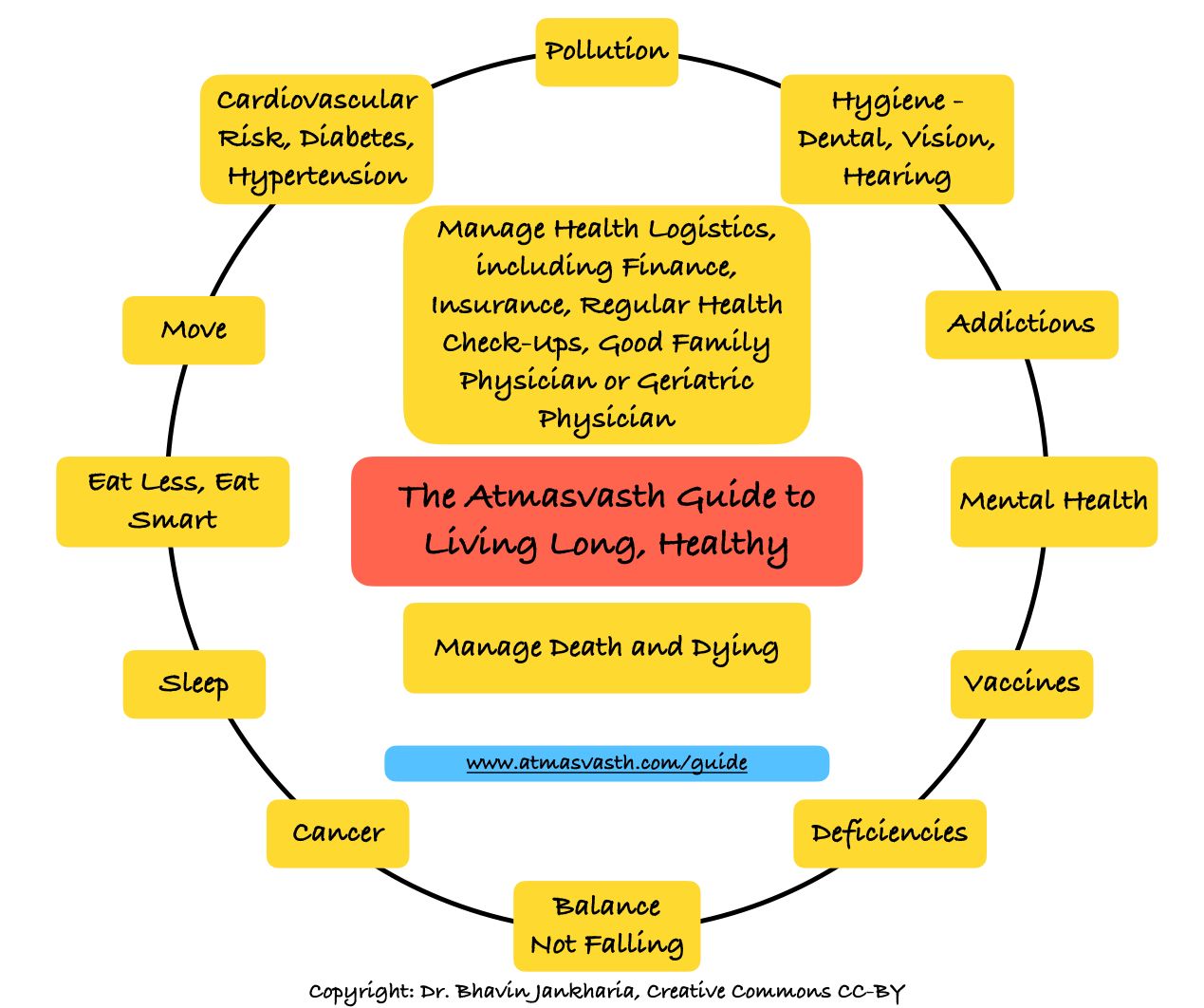Physical Activity Update - II (What, When, How Much)
Updated data on the impact of strength training and the step count needed and the "weekend warrior" phenomenon

The Book - Kindle Version Now Available Worldwide

The Detailed 15-Point Guide to Live Long, Healthy

Audio
Text
In the last 3 years, we have seen that “moving” improves healthspan and lifespan, helps with blood pressure control, improves white matter function, offsets the downsides of reduced sleep and reduces the rate of cognitive decline. We have noted that any physical activity is better than none, there is no age barrier to start being active, though the earlier you start the better…it is important to continue to be active throughout life. The sweet spot is 30-45 minutes of brisk walking a day (4000 steps), though the more you walk and the brisker you walk, the better it is. Running has added benefits and the better the cardiorespiratory reserve (CRF), the longer and better we live. Strength training is equally important and mixing walking/running with strength training gives the best results. In the end, any physical activity, including stairs climbing helps.
Last week, I discussed new data that has emerged in 2023 and early 2024 on the benefits of physical activity (PA). This piece focusses on the PA methodology.
Strength Training
There is less data on strength or resistance training, than on aerobic PA, such as walking, running, etc, though that is slowly, but surely, changing.
A recent study in JACC by Hongwei Ji and colleagues [1] focussed on how women derive greater gains in all-cause and cardiovascular mortality compared to men, from equivalent amounts of PA. While most of the study is about aerobic exercises, the authors also studied the impact of strength training and found that in those who engaged in regular strength training (average of 2 sessions per week), the men had a 11% mortality reduction, while the women had a 19% mortality reduction. Women derived an equivalent benefit with just one session per week, compared to 3 sessions per week that men needed. The numbers are significant, telling us that even 1-2 sessions per week of strength training for both sexes, will go a long way in improving healthspan and lifespan.
The American Heart Association (AHA) published a position statement in early 2024 [2] on the benefits of strength training along with recommendations (they call it resistance training). For the general population, the recommendation is 40-60% 1-RM, 8-12 repetitions (reps), 2 or more times a week, for both strength and endurance. 1-RM is the maximum you can lift a weight once. For e.g. if 5 kg is the maximum you can lift just once for a standing biceps curl, then the set will be 8-12 reps of 2-3 kg of weight, with 2-3 sets in each session. The article also mentions that you can use different ways to do strength training including your own body weight, resistance bands, free weights and machines, but your exercises should involve all the major muscle groups. A trainer is of help when doing all this.
It is therefore a good idea to mix things up…combined training (endurance and resistance on different days) is the best as I had discussed a couple of years ago, followed by hybrid training (combined on the same day).
Weekend versus Regular Weekdays - Every Minute Counts
Shaan Khurshid and colleagues [3] published a study using accelerometer derived data in 89,000 plus people that showed that those who concentrated their PA over the weekend had the same benefits as those who spread out their PA more evenly during the week. An accompanying editorial by Peter Katzmarzyk [4] mentions the phrase “every minute counts”…that any PA in any form, at any time, “counts”.
This information is relevant to many who have time only on weekends or Sundays and find it difficult to carve out time for PA during the working week. You can focus on meeting your PA targets over 1-2 days a week, if you don’t have time on working days.
Step Counts
Niels Stens and colleagues [5] did a meta-analysis of 12 studies till October 2022 that used objectively measured steps. Some of these, I have covered earlier here and here. What the authors found was that even 2800 steps/day led to an 8% reduction in all-cause mortality and 11% reduction in cardiovascular disease (CVD) risk, with a non-linear improvement in all-cause mortality and CVD risk with every 1000 step increase with an optimum step count of 8000. This again brings us to the same number - 4000, which is a good number to aim for and is practically possible for most people - brisk walking for 30-45 minutes a day. They also found that the better the cadence, the better the benefits.
Another recent study by Matthew Ahmadi and colleagues [6] looked at 72,000 odd UK Biobank individuals and checked their accelerometer based step counts with their levels of sedentary time, which was also calculated using the same accelerometer derived data. They found the same curves, i.e. mortality and CVD risk reduction benefits start at 2200 steps/day, with the best risk reduction at 9000-10,000 steps/day with a 10% improvement of CVD risk with a lower sedentary lifestyle. This means that apart from just the steps, if you are less sedentary, there are further benefits as well.

Timing of the PA
Hongliang Feng and colleagues [7] looked at the timing of the PA in a UK Biobank cohort of 92,000 odd people and found that moderate to vigorous physical activity (MVPA) at any time of the day was associated with lower risks for all-cause, cardiovascular and cancer mortality as multiple studies have shown and I discussed last week. This study showed that MVPA in the afternoon (11:00 to 17:00) or with mixed timings had still lower risks compared to the morning and evening groups, especially in elderly males, those who were less active and those with pre-existing cardiovascular disease. What this means is uncertain and the authors have given some explanations, but none of these are proven.
While there is increasing understanding of the impacts of the circadian rhythm on different parts of our body, the data is not robust enough and we need to wait for more studies to see if this pans out.
What does this mean for you and I?
- Any activity is better than none.
- Concentrating the PA during the weekend is as good as working out evenly during a week.
- Strength or resistance training should be part of the PA schedule.
- 4000 steps per day remains a sweet spot, though benefits accrue even at 2000 steps per day (20 mins of brisk walking).
Footnotes:
1. Ji H et al. Sex Differences in Association of Physical Activity With All-Cause and Cardiovascular Mortality. J Am Coll Cardiol. 2024 Feb 27;83(8):783-793.
2. Paluch AE et al. Resistance Exercise Training in Individuals With and Without Cardiovascular Disease: 2023 Update: A Scientific Statement From the American Heart Association. Circulation. 2024 Jan 16;149(3):e217-e231.
3. Khurshid S et al. Accelerometer-Derived "Weekend Warrior" Physical Activity and Incident Cardiovascular Disease. JAMA. 2023 Jul 18;330(3):247-252.
4. Katzmarzyk PT, Jakicic JM. Physical Activity for Health-Every Minute Counts. JAMA. 2023 Jul 18;330(3):213-214. doi: 10.1001/jama.2023.11014. PMID: 37462698.
5. Stens NA et al. Relationship of Daily Step Counts to All-Cause Mortality and Cardiovascular Events. J Am Coll Cardiol. 2023 Oct 10;82(15):1483-1494.
6. Ahmadi MN et al. Do the associations of daily steps with mortality and incident cardiovascular disease differ by sedentary time levels? A device-based cohort study. Br J Sports Med. 2024 Mar 8;58(5):261-268.
Atmasvasth Newsletter
Join the newsletter to receive the latest updates in your inbox.



